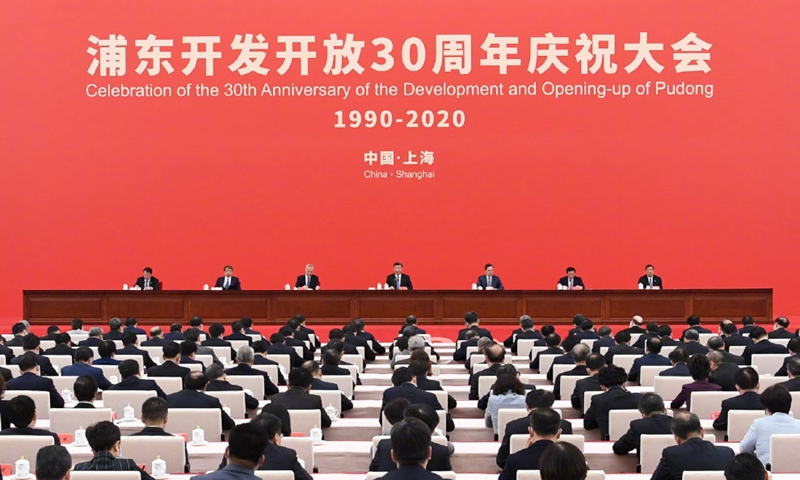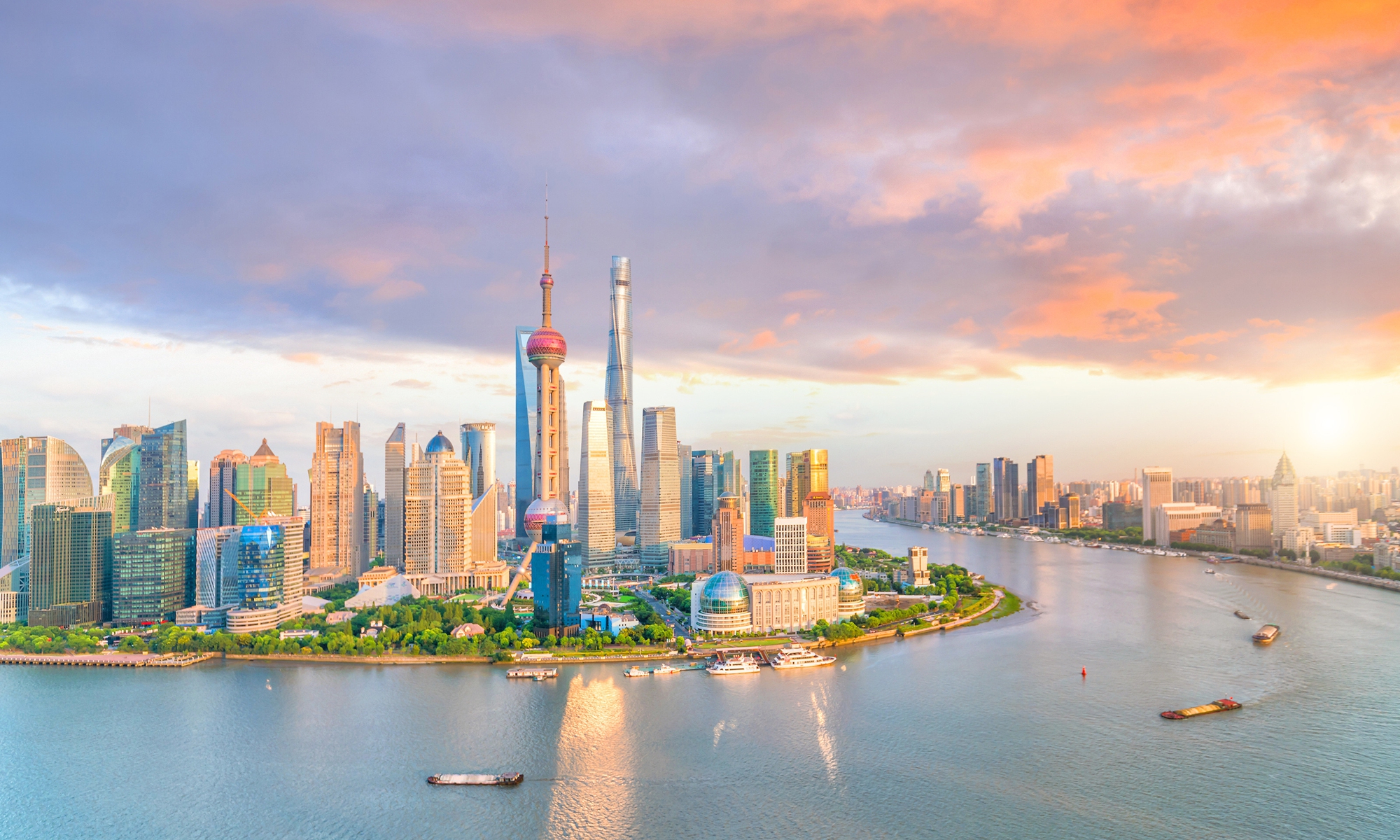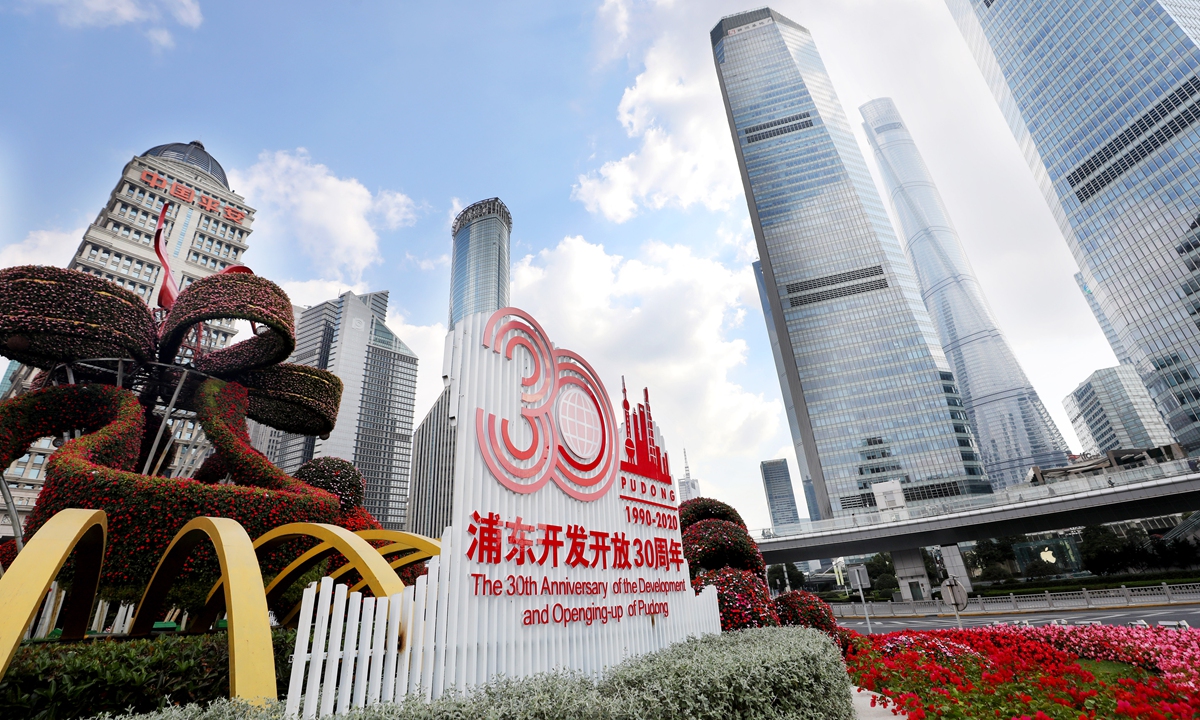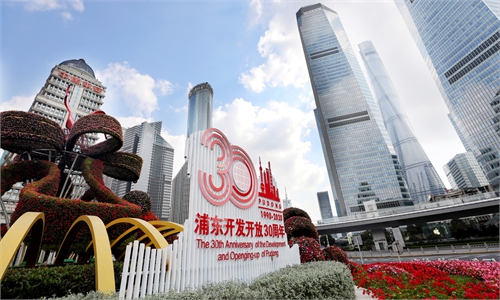Shanghai's Pudong New Area set to take the lead in further opening-up, self-reliant innovation

Photo: Xinhua
Twenty nine days ago, Chinese top leader elaborated to the world China's spirit of reform and opening-up and the unique successful road forged under the leadership of the Communist Party of China (CPC) at the 40th anniversary of the establishment of the Shenzhen Special Economic Zone (SEZ). On Thursday, another vanguard under the leadership of the CPC held a grand celebration to mark its 30th birthday.
China held on Thursday a grand gathering celebrating the 30th anniversary of the development and opening-up of Pudong, during which Chinese President Xi Jinping once again stressed the spirit of reform and opening-up and the importance of independent innovation to this country.
Shanghai is the birthplace of the Communist Party of China (CPC). We need to carry forward the red gene, constantly improve the quality and level of construction of the CPC, and ensure the right direction of reform and opening-up, Xi said.
Efforts should be made to make Pudong a pioneer of reform and opening-up at a higher level and a vanguard in fully building a modern socialist country, Xi said.
Pudong's new historical position and mission should be designed within the new development pattern with the domestic circulation as the main body along with "dual circulation," Xi said. "Dual circulation" is a new development pattern which uses the domestic market as the mainstay and allows domestic and foreign markets to boost each other.
The coming 30 years, from now to the middle of the 21st century, will be a time for China to build a great modern socialist country, Xi stressed, calling on Pudong to play new roles and accomplish new missions in the new march.
He urged the achievement of major innovations in basic science and technology and major breakthroughs in key and core technologies. He also called for speeding up the creation of world-class industrial clusters in sectors including integrated circuits, bio-medicine and artificial intelligence (AI).
The spirit of free trade, innovation and self-reliance — which has been cultivated in the development of Shanghai's Pudong New Area throughout the past three decades — has seen the area transformed from desolate farmland into a major growth engine of East China.The same spirit highlighted in the country's social and economic development plans for the next five to 15 years will help Shanghai spearhead China's further opening-up and inject great confidence into the world economy ravaged by the coronavirus pandemic, Chinese analysts said.
Chinese analysts said that Xi's speech expressed China's unwavering commitment to further opening-up, boosting the world's confidence in the Chinese economy and also stabilizing the world economy.
Stressing self-reliance on innovation is not only important for China's further reform and opening-up, but also a must amid the international uncertainties as the world watches change taking place in the US and in regards to China-US relations following the US election, Xu Hongcai, deputy director of the economic policy commission at the China Association of Policy Science, told the Global Times.
If Pudong back in 1990 can be compared to a young boy trying to throw off his shackles to move forward, today's Pudong has grown into a mature man just passing his 30th birthday and sprinting ahead with a strong physique and solid muscles, Wei Jianguo, former Chinese vice minister of commerce and executive deputy director of the China Center for International Economic Exchanges, told the Global Times on Thursday.
Thirty years ago, the development of Pudong was a major breakthrough for China against the West's doubts over its socialist path, and such a breakthrough required wisdom and courage, Xu said, noting that the achievement that Pudong has made reflected the central government's wise and thoughtful decision, proving to the world about the success of socialism with vitality and inclusiveness.
From opening a window in the past to opening the door right now and further opening up in the future, Pudong has remained a vanguard of the takeoff of the Chinese socialist market economy, and is expected to contribute more to the new goals set out in the country's recently announced 14th Five-Year Plan (2021-25) and longer-term visions up to 2035.

Shanghai Photo: IC
Stressing innovation
Emerging technologies represented by chips, AI, and biomedicine have become the focal point of competition between countries, due to not only their huge output value but also their crucial position in the industrial chain.
China will focus on achieving independence in key areas such as scientific research, according to the 14th Five-Year Plan.
Zhangjiang, the high-tech zone in Pudong, is striving to move in that direction.
The streets of Yuehai in Nanshan district of Shenzhen are under the spotlight as well, as major Chinese tech giants sanctioned by the US government are located there. But Chinese business representatives in Zhangjiang, the high-tech hub which is home to 229 chipset makers like Semiconductor Manufacturing International Corp (SMIC), appear to be facing a much tougher battle: the US' strangling of chipset supply, which has also delivered a heavy blow to the growth of China's technology sector.
"Some of the major equipment used in making chipsets is imported. For example, the EDA [Electronic Design Automation] tools are American products, and the US is also leading in manufacturing cutting-edge 7nm chips, so the extreme pressure inserted by the US government has brought many struggles to our factories," Tang Shiqing, director of the science and technology commission of the Pudong district government, told the Global Times.
The years-long trade war the US initiated against China has made more Chinese officials like Tang realize the importance of increasing efforts to boost self-reliance in the high-tech sector. Although some local officials and business representatives in Shanghai's chipset manufacturing hub do not believe a "complete decoupling" between China and the US will take place, they have reached a consensus that working on homegrown technologies should be the long-term strategy for not only companies but also for policymakers.
This change in thinking echoes China's top authority's major focuses on the country's social and economic development strategies in the medium-to-long term: boosting the domestic supply chain and homegrown innovation to become completely self-reliant in the economy and core technologies, given the continually mounting external risks.
For Wang Shumin, who returned from the US in 2004 and started up a semiconductor materials company in Pudong the same year, now is "the best time" for the domestic chipset industry to make breakthroughs with the help of attractive fundraising policies and a supportive business environment.
"After more than a decade of hard work and persistence, we have now become one of the major material suppliers to the China chipset market. We now have the capability to invest significantly more in research and development," Wang, who is the chairperson of Anji Microelectronics Technology Co, told the Global Times.
As a veteran business representative in the chipset supply chain, Wang firmly believes that the global semiconductor industry is open and highly integrated, while the "difficulties are temporary."
With a total 104.6 billion yuan in overall revenue for the chipset industry in Zhangjiang high-tech park, local authorities are not deterred by the US sanctions against China's high-tech companies, and vow to attract more investment in the next five years, including some "hardcore" technologies in cutting-edge materials, quantum science, innovation and AI.
Even though the China (Shanghai) Pilot Free Trade Zone was established only seven years ago in Pudong as the first of its kind in the country, it has fully inherited the pioneering spirit of its prototype. With reforms including the first negative list for foreign investment, Pudong has been committed to playing by international rules, pushing to establish systems for trade and investment facilitation.
To deepen reform in the Shanghai FTZ, Pudong will pilot the "one integrated license" system in 31 sectors, integrating the previously required multiple licenses into one for market access, the State Council executive meeting chaired by Premier Li Keqiang decided on Wednesday.
Tian Yun, vice director of the Beijing Economic Operation Association, told the Global Times on Thursday that innovative measures taken by the Shanghai pilot FTZ, which are internationally competitive, have served well its strategic goal of cultivating a global financial center.
"Under some necessary rules, economic innovation and activities have been injected with more impetus," Tian said.

Photo: Yang Hui/GT
Pudong's development over the past three decades has strengthened Shanghai's economic position as the leader of the Yangtze River Delta, and the economic development of the Yangtze River Delta region has further driven the integrated development of the entire Yangtze River Economic Belt. The total GDP of the belt accounted for 46 percent of China's total economic output in 2019, data from the National Bureau of Statistics showed.
In addition to Pudong, China has opened up a dozen cities, including Shenzhen in South China's Guangdong Province, with the Shenzhen Special Economic Zone celebrating its 40th anniversary of establishment just in October.
The combined economic size of the Guangdong-Hong Kong-Macao Greater Bay Area and the entire Yangtze River Economic Belt accounts for 60 percent of China's total economy, making Shenzhen and Shanghai two important megacities in the future Chinese economy.
These two pioneering cities in reform and opening-up will lead China's further opening-up to make the Chinese market a world market and inject momentum into the world's economic recovery amid the impact of the COVID-19 pandemic, Chinese analysts said.

